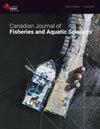Lakewater chemistry and its relationship to shoreline residential development and natural landscape features in Algonquin Provincial Park, Ontario, Canada
IF 2.2
2区 农林科学
Q2 FISHERIES
Canadian Journal of Fisheries and Aquatic Sciences
Pub Date : 2023-10-17
DOI:10.1139/cjfas-2023-0103
引用次数: 0
Abstract
There is a scarcity of long-term, chemical monitoring data for lakes in Algonquin Provincial Park (APP), with minimal understanding of the impacts of cottage-leases (e.g., cottage lots, campgrounds, and commercial leases) on lakewater chemistry. We examine spatial patterns in water chemistry and landscape features of 32 reference and 22 cottage-lease lakes in APP. Multivariate techniques were used to examine differences in water chemistry, and to identify the subset of landscape features that best explain this variability. Breakpoint analysis was used to examine the relationship between gradients of water chemistry and specific landscape features. Lakes were separated along a primary gradient of ions and pH and a secondary gradient of nutrients and colour. These gradients were best explained by a combination of six landscape features (wetlands, elevation, lake depth, road length, coniferous trees). Except for chloride, there was no statistically significant difference in water chemistry between cottage-lease and reference lakes. A roughly west-to-east gradient in catchment vegetation and lake chemistry was related to the location of the Algonquin Dome, a natural geological feature in APP, and the park’s glacial history. These results emphasize the importance of the park’s topography in influencing regional water chemistry.加拿大安大略省阿尔冈昆省立公园湖水化学及其与岸线住宅开发和自然景观特征的关系
阿尔冈昆省立公园(APP)湖泊的长期化学监测数据缺乏,对小屋租赁(例如,小屋地块、露营地和商业租赁)对湖水化学的影响了解很少。我们在APP中研究了32个参考湖泊和22个小屋租赁湖泊的水化学空间格局和景观特征。我们使用多变量技术来研究水化学的差异,并确定最能解释这种差异的景观特征的亚群。采用断点分析法考察了水体化学梯度与特定景观特征之间的关系。湖泊沿着离子和pH值的初级梯度和营养物质和颜色的次级梯度分开。这些梯度可以用六个景观特征(湿地、海拔、湖泊深度、道路长度、针叶树)的组合来最好地解释。除氯化物外,小屋租赁湖与参考湖的水化学成分无统计学差异。流域植被和湖泊化学大致由西向东的梯度与Algonquin Dome的位置(APP的自然地质特征)和公园的冰川历史有关。这些结果强调了公园地形对区域水化学影响的重要性。& # x0D;
本文章由计算机程序翻译,如有差异,请以英文原文为准。
求助全文
约1分钟内获得全文
求助全文
来源期刊

Canadian Journal of Fisheries and Aquatic Sciences
农林科学-海洋与淡水生物学
CiteScore
4.60
自引率
12.50%
发文量
148
审稿时长
6-16 weeks
期刊介绍:
The Canadian Journal of Fisheries and Aquatic Sciences is the primary publishing vehicle for the multidisciplinary field of aquatic sciences. It publishes perspectives (syntheses, critiques, and re-evaluations), discussions (comments and replies), articles, and rapid communications, relating to current research on -omics, cells, organisms, populations, ecosystems, or processes that affect aquatic systems. The journal seeks to amplify, modify, question, or redirect accumulated knowledge in the field of fisheries and aquatic science.
 求助内容:
求助内容: 应助结果提醒方式:
应助结果提醒方式:


